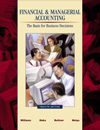Chapter 22 - Summary LO 1 Explain how a company can be "profit
rich, yet cash poor."Companies must often tie up large sums of cash in direct materials, work in
process, and finished goods inventories. As finished goods are sold, cash continues
to remain tied up in accounts receivable. Thus, a company may be reporting record
profits, yet still experience cash flow problems. LO 2
Discuss the benefits that a company may derive from a formal budgeting process.The benefits of budgeting are the benefits that come from thinking ahead. Budgeting
helps to coordinate the activities of the different departments, provides a
basis for evaluating department performance, and provides managers with responsibility
for future decision making. In addition, budgeting forces management to estimate
future economic conditions, including costs of materials, demand for the company's
products, and interest rates. LO 3
Explain two philosophies that may be used in setting budgeted amounts.The most widely used approach is to set budgeted amounts at levels that are
reasonably achievable under normal operating conditions. The goal in this case
is to make the budget a fair and reasonable basis for evaluating performance. An alternative is to budget an ideal level of performance. Under this approach,
departments normally fall somewhat short of budgeted performance, but the variations
may identify areas in which improvement is possible. LO 4
Describe the elements of a master budget.A "master budget" is a group of related budgets and forecasts that
together summarize all the planned activities of the business. A master budget
usually includes a sales forecast, production schedule, manufacturing costs
budget, operating expense budget, cash budget, capital expenditures budget,
and projected financial statements. The number and type of individual budgets
and schedules that make up the master budget depend on the size and nature of
the business. LO 5
Prepare the budgets and supporting schedules included in a master budget.A logical sequence of steps in preparing a master budget is discussed on pages
937--938. The operating budget estimates are used primarily in preparing a budgeted
income statement, whereas the financial estimates are used in preparing the
cash budget and budgeted balance sheets. LO 6
Prepare a flexible budget and explain its use.A flexible budget shows budgeted revenue, costs, and profits for different
levels of business activity. Thus a flexible budget can be used to evaluate
the efficiency of departments throughout the business even if the actual level
of business activity differs from management's original estimates. The amounts
included in a flexible budget at any given level of activity are based on cost-volume-profit
relationships. Chapter 22 serves as something of a link between the preceding several chapters
and the next two chapters. The preparation of a master budget closely relates
to the use of standard costs, covered in the next chapter, and draws heavily
on concepts regarding cost flows, product costing, cost-volume-profit analysis,
and responsibility accounting. In our next and final chapters, we will see how
managers select and utilize budget information for controlling operations and
when making decisions pertaining to investments in long-term assets. | 


 2002 McGraw-Hill Higher Education
2002 McGraw-Hill Higher Education